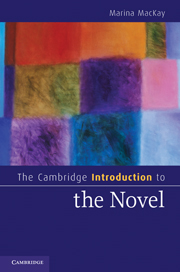Book contents
- Frontmatter
- Contents
- Acknowledgments
- About this book
- Chapter 1 Why the novel matters
- Miguel de Cervantes, Don Quixote (1605, 1615)
- Chapter 2 Origins of the novel
- Laurence Sterne, The Life and Opinions of Tristram Shandy, Gentleman (1759–67)
- Chapter 3 Narrating the novel
- James Hogg, The Private Memoirs and Confessions of a Justified Sinner (1824)
- Chapter 4 Character and the novel
- Nathaniel Hawthorne, The Scarlet Letter (1850)
- Chapter 5 Plotting the novel
- Gustave Flaubert, Madame Bovary (1857)
- Chapter 6 Setting the novel
- Charles Dickens, Bleak House (1853)
- Chapter 7 Time and history
- Virginia Woolf, To the Lighthouse (1927)
- Chapter 8 Genre and subgenre
- Graham Greene, The Ministry of Fear (1943)
- Chapter 9 Novel and anti-novel
- Thomas Pynchon, The Crying of Lot 49 (1966)
- Chapter 10 Novel, nation, community
- Salman Rushdie, Midnight's Children (1981)
- Chapter 11 Concluding
- Notes
- Glossary
- Further reading
- Index
- Cambridge Cultural Social Studies
Chapter 8 - Genre and subgenre
Published online by Cambridge University Press: 05 June 2012
- Frontmatter
- Contents
- Acknowledgments
- About this book
- Chapter 1 Why the novel matters
- Miguel de Cervantes, Don Quixote (1605, 1615)
- Chapter 2 Origins of the novel
- Laurence Sterne, The Life and Opinions of Tristram Shandy, Gentleman (1759–67)
- Chapter 3 Narrating the novel
- James Hogg, The Private Memoirs and Confessions of a Justified Sinner (1824)
- Chapter 4 Character and the novel
- Nathaniel Hawthorne, The Scarlet Letter (1850)
- Chapter 5 Plotting the novel
- Gustave Flaubert, Madame Bovary (1857)
- Chapter 6 Setting the novel
- Charles Dickens, Bleak House (1853)
- Chapter 7 Time and history
- Virginia Woolf, To the Lighthouse (1927)
- Chapter 8 Genre and subgenre
- Graham Greene, The Ministry of Fear (1943)
- Chapter 9 Novel and anti-novel
- Thomas Pynchon, The Crying of Lot 49 (1966)
- Chapter 10 Novel, nation, community
- Salman Rushdie, Midnight's Children (1981)
- Chapter 11 Concluding
- Notes
- Glossary
- Further reading
- Index
- Cambridge Cultural Social Studies
Summary
“Why pick up what literary history so resolutely discards?”
John Sutherland, Bestsellers (2007)“I adore stories that push on inexorably, frightening stories,” Flaubert's Emma Bovary explains: “I detest common heroes and temperate feelings, the way they are in life.” In view of the incongruity of Emma's sensationalist reading matter with her unromantic provincial scene, she seems to have found herself in the wrong kind of novel, in one of those realistically muted novels she deplores (“common heroes and temperate feelings”), rather than in the formula fictions she likes to read, with their “frightening stories,” their “stories that push on inexorably.” I mentioned earlier that Emma's own story picks up the qualities of the books she reads as it rushes “inexorably” to abandonment and ruin, madness and suicide, rejected conventions of an older escapism sneaking into Flaubert's ultra-modern realism. As Flaubert implies, and for reasons I hope to outline in this chapter, the barrier dividing “genre fiction” from “literary fiction” is never really as stable as it appears.
Genre fiction/literary fiction
The difference is clearly considered great enough to warrant literary and genre fiction occupying distinct sections of bookstore and library shelves. Genres are separated from one another in categories titled “mystery,” “romance,” “fantasy,” and the like, and all separated from the miscellaneous titles classified as “literature” or “literary fiction” or just “fiction.”
- Type
- Chapter
- Information
- The Cambridge Introduction to the Novel , pp. 135 - 143Publisher: Cambridge University PressPrint publication year: 2010

